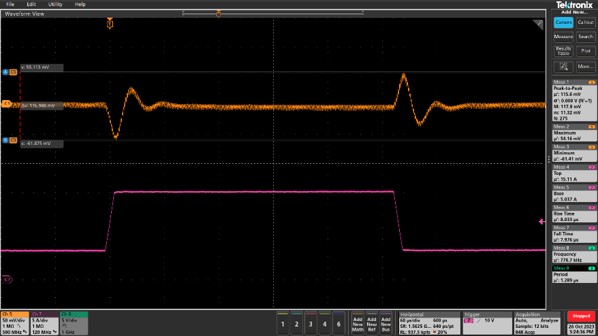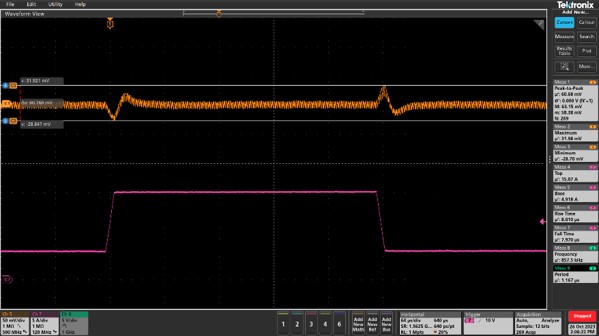SLVAF22C January 2021 – October 2024 TPS544C26 , TPS544C27 , TPS544E27 , TPS546C25 , TPS546E25 , TPS548A28 , TPS548B23 , TPS548B28 , TPS548C26 , TPS548D26 , TPS54J061 , TPS54KB20 , TPS54KC23 , TPS748A
- 1
- Abstract
- Trademarks
- 1Suggested DC/DC Converters
- 2Voltage Regulation Accuracy
- 3Load Transient Response with D-CAP4
- 4Security Features
- 5High Efficiency and Thermal Performance
- 6Linear Regulator with Adjustable Soft-Start and High Output Voltage Accuracy
- 7Conclusion
- 8Additional Resources
- 9Revision History
3 Load Transient Response with D-CAP4
Since the load profile can change dramatically in an enterprise rack server, it is important to consider AC transient performance. Choosing a DC/DC converter with a fast transient response using non-linear control techniques, such as constant on-time or D-CAP4™, allows a fast transient response with minimal output capacitance. The D-CAP4 control architecture includes an internal ripple generation network enabling the use of very low ESR output capacitors such as multi-layered ceramic capacitors (MLCC) and low ESR polymer capacitors. No external current sensing network or voltage compensator are required with D-CAP4 control architecture. The role of the internal ripple generation network is to emulate the ripple component of the inductor current information and then combine with the voltage feedback signal to regulate the loop operation. D-CAP4 control architecture is different from D-CAP3™ and reduces loop gain variation across the output voltage, enabling a fast load transient response across the entire output voltage range with one ramp setting, especially at higher output voltages, like 3.3V and 5V. The R-C time-constant of the internal ramp circuit sets the zero frequency of the ramp, similar to other R-C based internal ramp generation architectures. The reduced variation in loop gain also mitigates the need for a feed-forward capacitor to optimize the transient response. The ramp amplitude varies with the input voltage to minimize variation in loop gain across input voltage, commonly referred to as input voltage feed-forward. Converters with D-CAP4, as well as D-CAP3, use internal circuitry to correct for the dc offset caused by the injected ramp, and removes the dc offset caused by the output ripple voltage, especially with light load current when skip mode operation is selected. Figure 3-1 shows D-CAP3 and Figure 3-2 shows D-CAP4 transient response comparisons under the same operating conditions with a 5-A to 15-A load step, 1-A/μs slew rate, 3.3V output and 800kHz switching frequency. D-CAP4 performed better with a 60.7mV droop and overshoot voltage response compared to D-CAP3's 117mV droop and overshoot response, with both converters using the same 470nH inductor and 570μF of total output capacitance.
 Figure 3-1 TPS54JB20 Transient Response
with D-CAP3
Figure 3-1 TPS54JB20 Transient Response
with D-CAP3 Figure 3-2 TPS54KB20 Transient Response
with D-CAP4
Figure 3-2 TPS54KB20 Transient Response
with D-CAP4